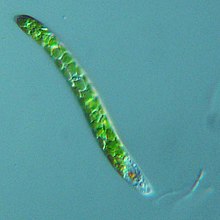
Euglenozoa are a large group of flagellate Discoba. They include a variety of common free-living species, as well as a few important parasites, some of which infect humans. Euglenozoa are represented by four major groups, i.e., Kinetoplastea, Diplonemea, Euglenida, and Symbiontida. Euglenozoa are unicellular, mostly around 15–40 μm (0.00059–0.00157 in) in size, although some euglenids get up to 500 μm (0.020 in) long.

Euglena is a genus of single cell flagellate eukaryotes. It is the best known and most widely studied member of the class Euglenoidea, a diverse group containing some 54 genera and at least 200 species. Species of Euglena are found in fresh water and salt water. They are often abundant in quiet inland waters where they may bloom in numbers sufficient to color the surface of ponds and ditches green (E. viridis) or red (E. sanguinea).
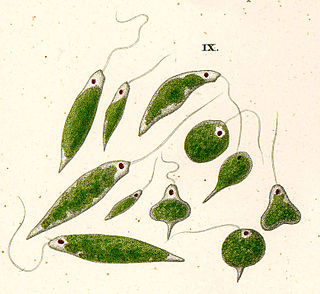
Euglenids or euglenoids are one of the best-known groups of flagellates. They are excavate eukaryotes of the phylum Euglenophyta, classified as class Euglenida or Euglenoidea. Euglenids are commonly found in freshwater, especially when it is rich in organic materials, with a few marine and endosymbiotic members. Many euglenids feed by phagocytosis, or strictly by diffusion. A monophyletic group known as Euglenophyceae have chloroplasts and produce their own food through photosynthesis. This group is known to contain the carbohydrate paramylon.

Telonemia is a phylum of microscopic eukaryotes commonly known as telonemids. They are unicellular free-living flagellates with a unique combination of cell structures, including a highly complex cytoskeleton unseen in other eukaryotes.

Euglenaceae is a family of flagellates in the phylum Euglenozoa. The family includes the most well-known euglenoid genus, Euglena.

Protozoan infections are parasitic diseases caused by organisms formerly classified in the kingdom Protozoa. These organisms are now classified in the supergroups Excavata, Amoebozoa, Harosa, and Archaeplastida. They are usually contracted by either an insect vector or by contact with an infected substance or surface.

Ochrophytes, also known as heterokontophytes or stramenochromes, are a group of algae. They are the photosynthetic stramenopiles, a group of eukaryotes, organisms with a cell nucleus, characterized by the presence of two unequal flagella, one of which has tripartite hairs called mastigonemes. In particular, they are characterized by photosynthetic organelles or plastids enclosed by four membranes, with membrane-bound compartments called thylakoids organized in piles of three, chlorophyll a and c as their photosynthetic pigments, and additional pigments such as β-carotene and xanthophylls. Ochrophytes are one of the most diverse lineages of eukaryotes, containing ecologically important algae such as brown algae and diatoms. They are classified either as phylum Ochrophyta or Heterokontophyta, or as subphylum Ochrophytina within phylum Gyrista. Their plastids are of red algal origin.

Protozoa are a polyphyletic group of single-celled eukaryotes, either free-living or parasitic, that feed on organic matter such as other microorganisms or organic debris. Historically, protozoans were regarded as "one-celled animals".

Calkinsia is a monotypic genus of excavates comprising the single species Calkinsia aureus. It lives in low-oxygen seafloor environments. It is not classified in any of the three well-known groups of the Euglenozoa, but is placed in its own group, the Symbiontida. Some authors have classified Calkinsia alongside Postgaardi, but Postgaardi has not been studied well enough to test this hypothesis.

Phacus is a genus of unicellular excavates, of the phylum Euglenozoa, characterized by its flat, leaf-shaped structure, and rigid cytoskeleton known as a pellicle. These eukaryotes are mostly green in colour, and have a single flagellum that extends the length of their body. They are morphologically very flat, rigid, leaf-shaped, and contain many small discoid chloroplasts.

Peranema is a genus of free-living phagotrophic euglenids. There are more than 20 nominal species, varying in size between 8 and 200 micrometers. Peranema cells are gliding flagellates found in freshwater lakes, ponds and ditches, and are often abundant at the bottom of stagnant pools rich in decaying organic material. Although they belong to the class Euglenoidea, and are morphologically similar to the green Euglena, Peranema have no chloroplasts, and do not conduct autotrophy. Instead, they capture live prey, such as yeast, bacteria and other flagellates, consuming them with the help of a rigid feeding apparatus called a "rod-organ." Unlike the green euglenids, they lack both an eyespot (stigma), and the paraflagellar body (photoreceptor) that is normally coupled with that organelle. However, while Peranema lack a localized photoreceptor, they do possess the light-sensitive protein rhodopsin, and respond to changes in light with a characteristic "curling behaviour."
The initial version of a classification system of life by British zoologist Thomas Cavalier-Smith appeared in 1978. This initial system continued to be modified in subsequent versions that were published until he died in 2021. As with classifications of others, such as Carl Linnaeus, Ernst Haeckel, Robert Whittaker, and Carl Woese, Cavalier-Smith's classification attempts to incorporate the latest developments in taxonomy., Cavalier-Smith used his classifications to convey his opinions about the evolutionary relationships among various organisms, principally microbial. His classifications complemented his ideas communicated in scientific publications, talks, and diagrams. Different iterations might have a wider or narrow scope, include different groupings, provide greater or lesser detail, and place groups in different arrangements as his thinking changed. His classifications has been a major influence in the modern taxonomy, particularly of protists.
Heteronema is a genus of phagotrophic, flagellated euglenoids that are most widely distributed in fresh water environments. This genus consists of two very distinguishable morphogroups that are phylogenetically closely related. These morphogroups are deciphered based on shape, locomotion and other ultrastructural traits. However, this genus does impose taxonomic problems due to the varying historical descriptions of Heteronema species and its similarity to the genus Paranema. The species H. exaratum, was the first heteronemid with a skidding motion to be sequenced, which led to the discovery that it was not closely related to H. scaphrum, contrary to what was previously assumed, but instead to a sister group of primary osmotrophs. This suggests that skidding heteronemids can also be distinguished phylogenetically, being more closely related to Anisoma, Dinema and Aphageae, than to other species within Heteronema.

Marine protists are defined by their habitat as protists that live in marine environments, that is, in the saltwater of seas or oceans or the brackish water of coastal estuaries. Life originated as marine single-celled prokaryotes and later evolved into more complex eukaryotes. Eukaryotes are the more developed life forms known as plants, animals, fungi and protists. Protists are the eukaryotes that cannot be classified as plants, fungi or animals. They are mostly single-celled and microscopic. The term protist came into use historically as a term of convenience for eukaryotes that cannot be strictly classified as plants, animals or fungi. They are not a part of modern cladistics because they are paraphyletic.
Postgaardia is a proposed basal clade of flagellate Euglenozoa, following Thomas Cavalier-Smith. As of April 2023, the Interim Register of Marine and Nonmarine Genera treats the group as a subphylum. A 2021 review of Euglenozoa places Cavalier-Smith's proposed members of Postgaardia in the class Symbiontida. As Euglenozoans may be basal eukaryotes, the Postgaardia may be key to studying the evolution of Eukaryotes, including the incorporation of eukaryotic traits such as the incorporation of alphaproteobacterial mitochondrial endosymbionts.
Anisonemidae is a small family of euglenid algae, with two accepted genera. It is the only family in the order Anisonemida.

Urceolus is a genus of heterotrophic flagellates belonging to the Euglenozoa, a phylum of single-celled eukaryotes or protists. Described by Russian biologist Konstantin Mereschkowsky in 1877, its type species is Urceolus alenizini. Species of this genus are characterized by deformable flask-shaped cells that exhibit at least one flagellum that is active at the tip, arising from a neck-like structure that also hosts the feeding apparatus. They are found in a variety of water body sediments across the globe. According to evolutionary studies, Urceolus belongs to a group of Euglenozoa known as peranemids, closely related to the euglenophyte algae.
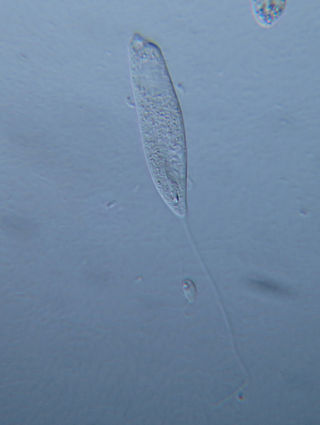
The peranemids are a group of phagotrophic flagellates, single-celled eukaryotes or protists. They belong to the Euglenida, a diverse lineage of flagellates that contains the closely related euglenophyte algae. Like these algae, peranemids have flexible cells capable of deformation or metaboly, and have one or two flagella in the anterior region of the cell. They are classified as family Peranemidae (ICZN) or Peranemataceae (ICBN) within the monotypic order Peranemida (ICZN) or Peranematales (ICBN).
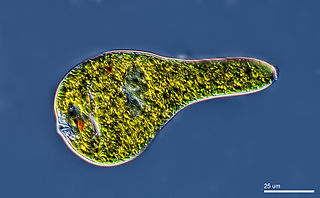
Spirocuta is a clade of euglenids, single-celled eukaryotes or protists belonging to the phylum Euglenozoa. They are distinguished from other euglenids by active deformation of their cell shape, a process called euglenid motion or metaboly. This is made possible by a high number of spirally arranged protein strips that run below their cell membrane and confer the cell with flexibility. These strips compose the helicoidal pellicle, a trait referenced by the alternative name Helicales.
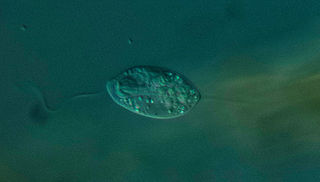
Anisonemia is a clade of single-celled protists belonging to the phylum Euglenozoa, relatives of the Euglenophyceae algae. They are flagellates, with two flagella for locomotion. Anisonemia includes various phagotrophic species and a group of primary osmotrophic protists known as Aphagea.
